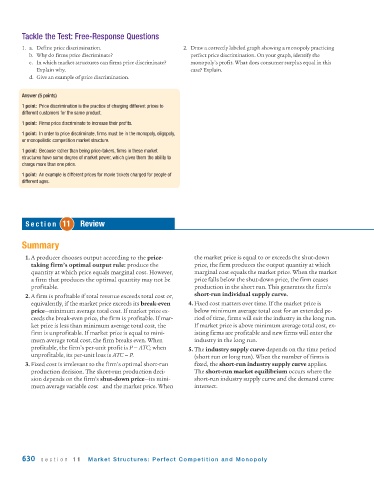Page 672 - Krugmans Economics for AP Text Book_Neat
P. 672
Tackle the Test: Free-Response Questions
1. a. Define price discrimination. 2. Draw a correctly labeled graph showing a monopoly practicing
b. Why do firms price discriminate? perfect price discrimination. On your graph, identify the
c. In which market structures can firms price discriminate? monopoly’s profit. What does consumer surplus equal in this
Explain why. case? Explain.
d. Give an example of price discrimination.
Answer (5 points)
1 point: Price discrimination is the practice of charging different prices to
different customers for the same product.
1 point: Firms price discriminate to increase their profits.
1 point: In order to price discriminate, firms must be in the monopoly, oligopoly,
or monopolistic competition market structure.
1 point: Because rather than being price-takers, firms in these market
structures have some degree of market power, which gives them the ability to
charge more than one price.
1 point: An example is different prices for movie tickets charged for people of
different ages.
Section 11 Review
Summary
1. A producer chooses output according to the price- the market price is equal to or exceeds the shut-down
taking firm’s optimal output rule: produce the price, the firm produces the output quantity at which
quantity at which price equals marginal cost. However, marginal cost equals the market price. When the market
a firm that produces the optimal quantity may not be price falls below the shut-down price, the firm ceases
profitable. production in the short run. This generates the firm’s
2. A firm is profitable if total revenue exceeds total cost or, short-run individual supply curve.
equivalently, if the market price exceeds its break-even 4. Fixed cost matters over time. If the market price is
price—minimum average total cost. If market price ex- below minimum average total cost for an extended pe-
ceeds the break-even price, the firm is profitable. If mar- riod of time, firms will exit the industry in the long run.
ket price is less than minimum average total cost, the If market price is above minimum average total cost, ex-
firm is unprofitable. If market price is equal to mini- isting firms are profitable and new firms will enter the
mum average total cost, the firm breaks even. When industry in the long run.
profitable, the firm’s per-unit profit is P − ATC; when 5. The industry supply curve depends on the time period
unprofitable, its per-unit loss is ATC − P. (short run or long run). When the number of firms is
3. Fixed cost is irrelevant to the firm’s optimal short-run fixed, the short-run industry supply curve applies.
production decision. The short-run production deci- The short-run market equilibrium occurs where the
sion depends on the firm’s shut-down price—its mini- short-run industry supply curve and the demand curve
mum average variable cost—and the market price. When intersect.
630 section 11 Market Structures: Perfect Competition and Monopoly

